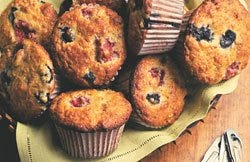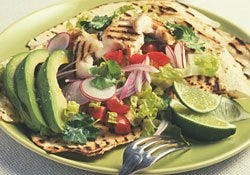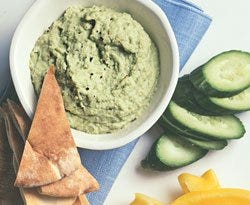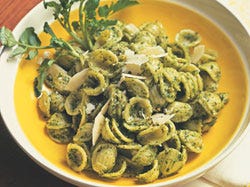Diet Pills That Make You Poop Out Fat
Confess: Earlier this year, when you heard news reports that a major study found that low-fat diet foods don't prevent breast or colon cancer or heart disease in women, didn't you want to run out and order fettuccine Alfredo? Cheesecake? A pint of Häagen-Dazs Triple Chocolate?
Trouble is, those reports neglected healthy fats and left us with the wrong impression--namely, that we could give up fat free diet foods for fat free-for-all. That, alas, is not the case. The study--the Women's Health Initiative, the largest health assessment ever of postmenopausal women--treated all fats as though they were the same. So, for the purposes of research, adding avocado slices to a salad or snacking on a handful of almonds was considered roughly the equivalent of eating a fatty roast beef sandwich or noshing on pork rinds. That's like comparing, well, almonds and pork rinds.
"Not all fats are created equal," says Roberta Anding, RD, a clinical dietitian at Baylor College of Medicine. "Maybe a low-fat diet isn't the way we need to eat, but a right-fat diet is."
Like other animal products, pork rinds contain saturated fat, which is linked to increased risk of both heart disease and cancer. Healthy fats mainly come from plants and fish: the monounsaturated fats in almonds and avocados, the polyunsaturated fats in soy and seeds, the omega-3 fatty acids in walnuts (and fish), and the omega-6 fatty acids in nuts and seeds and their oils. Studies have shown that they may lower your odds of a multitude of conditions, including heart disease, cancer, Alzheimer's, and depression.
And though all fats, healthy or otherwise, contain a fair amount of calories (about 9 per gram), a little bit may keep you from getting ravenous between meals. Healthy fats as diet foods? Sure, as long as you keep your fat calories to no more than 30% of total calories, or roughly 57 g of fat a day for women. To put that in perspective, one large container of fast-food fries supplies about 28 g of fat; add a steak (23 g in 6 ounces) and that piece of cheesecake (18 g per slice), and you've blown it.
So go ahead, follow your initial impulse and fatten up your diet. But make sure you do it with these healthy fats diet foods (which we've used in four delicious recipes, found on the following pages).
Avocados
Eat them because They contain heart-healthy monounsaturated fats. Monos help lower total and "bad" LDL cholesterol. Some studies suggest that a high-mono diet may even protect against breast cancer. Recent research at Ohio State University found that when avocado was added to salads and salsa, it helped increase the absorption of specific carotenoids, chemicals linked to lower risk of heart disease and macular degeneration, a leading cause of blindness.
"Avocados are packed with other heart-protective compounds, such as soluble fiber, vitamin E, folate, and potassium," says Elizabeth Somer, RD, author of 10 Habits That Mess Up a Woman's Diet.
Get more Avocados aren't just for guacamole anymore. Start a summer meal with a refreshing bowl of chilled avocado soup (puree an avocado in a blender with 2 tablespoons of plain yogurt and a dash of lime juice and hot sauce, thinning the soup to taste with reduced-sodium chicken broth). Mash a quarter of an avocado to use in place of a tablespoon of mayonnaise on deli sandwiches of turkey or lean ham; you'll slash total fat (the avocado has 7 g, full-fat mayo has 11 g) and add beneficial monounsaturated fat, which you won't get by switching to fat-free mayo.
Nutrient Profile 1/5 avocado: 4.6 g fat* (2.9 g monounsaturated, 0.6 g polyunsaturated, 0.6 g saturated), 50 calories
*Fat breakdowns are approximate.[pagebreak]
Olives & Olive Oil
Eat them because Olives and their oil are one of nature's most abundant sources of beneficial monos. But that's only the beginning for these diet foods. They also contain phytochemicals like polyphenols. "These protective compounds may prevent both cardiovascular disease and cancer and reduce inflammation that can lead to chronic illness," says Somer. A recent Spanish study found that among 755 women in the Canary Islands, where the breast cancer rate is higher than in the rest of Spain, those who consumed the most olive oil--more than 8.8 g, or about a third of an ounce, a day--were least likely to get the disease.
Get more Skewer pitted olives among grilled shrimp, peppers, and onions, or stir chunks into spicy putta-nesca sauce and serve over pasta or fish. Swap mayo for flavorful store-bought olive paste (called tapenade, and a teaspoon will do) on sandwiches or salads. Olive oil is an excellent butter substitute on steamed or grilled veggies: Drizzle 1 or 2 teaspoons over grilled asparagus or steamed broccoli and lightly dust the veggies with grated cheese and a grind of black pepper. Choose extra virgin olive oil--it contains the highest level of healthy phenolic compounds.
Nutrient Profile Five large olives: 2.4 g fat (1.7 g monounsaturated, 0.2 g polyunsaturated, 0.3 g saturated), 25 calories. 1 tablespoon oil: 13.5 g fat (9.9 g monounsaturated, 1.4 g polyunsaturated, 1.9 g saturated), 120 calories
Peanuts & Peanut Butter
Eat them because Five of the largest epidemiological studies in the United States found that eating nuts reduces the risk of heart disease. In the Nurses' Health Study at Harvard, eating at least 5 ounces of nuts a week lowered cardiovascular disease risk by 35%, probably because of their healthy fats.
Peanuts and peanut butter pack a lot of calories--170 per ounce of nuts, 94 for 1 tablespoon of peanut butter--but Pennsylvania State University research found that among more than 14,000 people, those who were regular peanut and peanut-butter snackers actually had a lower body mass index, a measure of obesity, and lower cholesterol intake than those who didn't eat peanuts. Peanuts also contain beta-sitosterol, a plant chemical that blocks cholesterol absorption from foods and appears to inhibit tumor growth in the colon, prostate, and breast.
Get more Crush them and sprinkle a few tablespoons over coleslaw, rice dishes, shrimp or chicken salad, or a tropical fruit salad. Peanut butter isn't married to jelly. Spread 2 tablespoons of your favorite full-fat (the good stuff is in the fat) brand on whole wheat bread and add sliced apples, pears, or bananas. Mix 1/4 cup of peanut butter with 1 tablespoon each of reduced-sodium chicken broth and soy sauce to create a rich, exotic sauce for grilled chicken, noodle dishes, or salad.
Nutrient Profile 28 peanuts (1 ounce): 14 g fat (7 g monounsaturated, 4.5 g polyunsaturated, 2 g saturated), 166 calories. 1 tablespoon peanut butter: 8.1 g fat (3.8 g monounsaturated, 2.2 g polyunsaturated, 1.7 g saturated), 94 calories
Edamame (soybeans)
Eat them because Though recent studies have cast doubt on soy's ability to independently lower your risk of heart disease, it's a great substitute for meat in your diet, and that can help lower your cholesterol. A multicenter study, published in the March issue of the American Journal of Clinical Nutrition, found that a diet that substituted soy products for meat and contained specific kinds of fiber (such as that in oats), almonds, and plant-sterol-enriched margarine, lowered cholesterol as much as statin drugs (more than 20%) for one-third of the participants.
Get more Keep a bag of frozen, precooked edamame on hand and add 1*4 cup to stir-fries, vegetable stews, or whole wheat pasta dishes to boost polyunsaturated fat and protein. Toss them with some corn for an unusual succotash. Use them to replace meat in a stir-fry of broccoli, bok choy, and asparagus. Or substitute them for chickpeas in hummus.
Nutrient Profile 1 cup cooked edamame: 11.5 g fat (2.2 g monoun-saturated, 5.4 g polyunsaturated, 1.3 g saturated), 254 calories[pagebreak]
Sunflower Seeds
Eat them because You need to get linoleic acid in your diet: Your body can't make it (as well as other essential fatty acids), and requires it to help synthesize other fats. Bonus: It's great for your heart. In the Nurses' Health Study, women who had the highest intakes of linoleic acid had a 23% lower risk of heart disease than women who had the lowest intakes.
Get more Add 2 or 3 tablespoons of these delicately flavored seeds to low-fat granola, trail mix, or hot cereal. Or lightly toast and sprinkle them and dried cherries on top of a spinach salad dressed with a citrus vinaigrette. Use a tablespoon as a topping for an open-faced tuna, egg salad, or hummus sandwich on crusty pumpernickel bread. Storage tip: Sunflower seeds easily become rancid, causing them to lose their nutritional benefits and develop off flavors, so store them in a tightly sealed container in the refrigerator.
Nutrient Profile 1/4 cup sunflower seeds: 15.9 g fat (3 g monounsaturated, 10.5 g polyunsaturated, 1.7 g saturated), 10.5 g linoleic acid, 186 calories
Walnuts
Eat them because "Hands down, walnuts have the highest level of omega-3 fats of any nut," says Somer. In fact, walnuts are one of the few plant sources of the healthy fats that may protect against inflammation, heart disease, asthma, and arthritis and improve cognitive function. "Just one small handful [14 walnut halves] supplies 2.6 g of omega-3 fats, which surpasses the minimal daily amount recommended by the Institute of Medicine for optimal health."
Get more These fragrant nuts lend themselves to both sweet and savory dishes. They're suited to crisp oatmeal cookies or a rich banana bread, but they also add spark and crunch to a butternut squash risotto, roasted brussels sprouts, or mashed sweet potatoes. To stave off hunger, add 2 tablespoons of crushed walnuts to your morning cereal, or mix a teaspoon of chopped walnuts with six dried apricot halves for an on-the-go snack.
Nutrient Profile 14 walnut halves (1 ounce): 18.5 g fat (2.5 g monounsaturated, 13.4 g polyunsaturated, 1.7 g saturated), 185 calories
Flaxseed
Eat it because Flaxseed is famous for its omega-3s, but it's also an outstanding source of lignans, a type of fiber that acts like a weak form of estrogen in our bodies and may help fight some types of breast cancer.
Researchers at the University of Toronto and Massachusetts General Hospital Cancer Center in Boston, who analyzed tumor tissue, found that tumor growth slowed significantly and cancer cell death increased by as much as 30% in recently diagnosed postmenopausal breast cancer patients who ate a muffin containing about 3 tablespoons of flaxseed daily for about a month before surgery.
Get more Its nutty flavor makes flaxseed a natural addition to baked goods and breakfast foods. You must grind the hull from the seed to release all of flax's nutrients. Add 1/4 cup of ground seeds to pancakes, muffins, cookies, and quick breads (but watch baking times--flaxseed can cause food to brown more quickly). Add a tablespoon or two to cereal, yogurt, soups, or fresh-fruit smoothies. Flax is best stored in the refrigerator, and ground flaxseed must be used promptly because it spoils more quickly than the whole seed.
Nutrient Profile 2 tablespoons ground flaxseed: 5.9 g fat (1.1 g monounsaturated, 4 g polyunsaturated, 0.5 g saturated), 75 calories
Almonds
Eat them because They'll do your heart good. In a study at the University of California, Davis, researchers substituted almonds and almond oil for half the fat in the diets of their volunteers: slightly more than 2 1/2 ounces of almonds (about 48 nuts) and nearly 1 1/2 ounces of almond oil daily. At the end of 6 weeks, the 22 men and women had lower total cholesterol (a drop of 4%), lower LDL levels (a drop of 6%), and significantly lower triglycerides (a 14% drop), while their HDL levels went up by 6%.
Get more Sprinkle a tablespoon or two of slivered almonds over whole wheat couscous or steamed jasmine rice with peas. Tuck them into beef or poultry dishes or use them to top a curried vegetable stew or carrot soup. For a light summer dessert, sprinkle a tablespoon of crushed almonds over grilled figs, nectarines, or peaches drizzled with balsamic vinegar. For a twist on an old favorite, use almond butter on your PB&J.
Nutrient Profile 23 almonds (1 ounce): 14.4 g fat (9.1 g monounsaturated, 3.5 g polyunsaturated, 1.1 g saturated), 164 calories
Quicktip
Many plant oils--such as walnut, olive, and sunflower--are excellent sources of healthy fats but don't supply the fiber and some of the nutrients of the whole foods they come from.[pagebreak]
Almond and Mixed Berry Muffins with Flaxseed

| | |
1. Position rack in middle of oven. Preheat oven to 400°F. Line 12-cup muffin pan with paper liners.
2. In large bowl, whisk flours, baking powder, salt, and flaxseed to combine. Add berries and stir to coat.
3. In another bowl, whisk eggs, milk, sugar, oil, and vanilla extract to combine.
4. Pour egg mixture into berry mixture and gently mix with a fork to moisten dry ingredients. Don't overmix (a few lumps in batter are normal). Pour batter into muffin cups.
5. Bake until muffins are puffed and wooden pick inserted into center comes out clean, 20 to 24 minutes. Cool 5 minutes on rack before serving.
Makes 12 Servings
Per Serving: 240 cal, 5 g pro, 30 g carb, 11 g fat, 1.5 g sat fat, 35 mg chol, 2 g fiber, 280 mg sodium
Prep Time: 12 minutes
Cooking Time: 24 minutes[pagebreak]
Grilled Tilapia and Avocado Tostada

| | |
1. Preheat grill or grill pan to medium-high heat.
2. Brush tortillas with 1 tablespoon of the oil. Grill, flipping once or twice, until crisp, about 2 minutes each.
3. Brush tilapia on both sides with 1 tablespoon of the oil and sprinkle with 1/4 teaspoon of the salt. Grill, flipping once, until cooked through, about 8 minutes. Let rest 4 minutes and pull into chunks with fork.
4. Place each tortilla on a plate. Scatter on onion, lettuce, tomatoes, cilantro, and radishes. Lay tilapia pieces on top. Fan sliced avocado quarters over tilapia and sprinkle with the remaining 1/4 teaspoon salt and 1 tablespoon oil. Serve with lime wedges.
Makes 4 Servings
Per Serving: 380 cal, 26 g pro, 31 g carb, 19 g fat, 3.5 g sat fat, 55 mg chol, 5 g fiber, 660 mg sodium
Prep Time: 18 minutes
Cooking Time: 16 minutes[pagebreak]
Edamame Hummus

| | |
1. In large pot, bring 2 quarts of water to a rapid boil. Pour in edamame. Return to a boil and cook about 6 minutes, until beans are creamy inside and easy to smash with fork. Drain edamame and dunk in large bowl of cold water, about 3 minutes. Drain when cool.
2. In blender or food processor, combine edamame, tahini, oil, lemon juice, garlic, and salt. Pulse, scraping down sides occasionally until mixture is pureed smooth. Add cold water, a little at a time, until hummus is creamy.
3. Serve as a dip with toasted pita or seasonal vegetables such as cucumber, squash, or orange bell pepper.
Makes 8 Servings (1/4 c each)
Per Serving: 170 cal, 7 g pro, 9 g carb, 12 g fat, 1.5 g sat fat, 0 mg chol, 3 g fiber, 140 mg sodium
Prep Time: 9 minutes
Cooking Time: 6 minutes[pagebreak]
Walnut Pesto on Orecchiette

| | |
1. Prepare orecchiette per package directions. Drain, reserving 3 tablespoons of pasta water, and set aside.
2. In food processor, combine walnuts, sunflower seeds, 3 tablespoons of the cheese, and garlic, and pulse to form crumbs. Add watercress (reserve a few leaves for garnish) and process, scraping down sides once or twice, to form paste. Add oil and pulse until combined. Transfer pesto into large bowl.
3. Add reserved pasta cooking water and orecchiette to pesto and toss to coat. Serve sprinkled with remaining 1 tablespoon cheese. Garnish with watercress leaves.
Makes 4 Servings
Per Serving: 450 cal, 13 g pro, 50 g carb, 22 g fat, 3 g sat fat, 5 mg chol, 3 g fiber, 115 mg sodium
Prep Time: 10 minutes
Cooking Time: 11 minutes
This content is created and maintained by a third party, and imported onto this page to help users provide their email addresses. You may be able to find more information about this and similar content at piano.io
Diet Pills That Make You Poop Out Fat
Source: https://www.prevention.com/food-nutrition/healthy-eating/a20454046/diet-foods-and-healthy-fats/
0 Response to "Diet Pills That Make You Poop Out Fat"
Post a Comment